



Curated by Sarah Cook together with the Director of Somerset House, Jonathan Reekie.
Economy has re-invented time. Development of industrialism and accompanying its advancements, for example, the invention of the railroad, forced standardisation of time. During 1700-1900 this invention increased methods of moving goods, new technologies and large scale investment in the UK’s countries infra-structure (communications network). The result was a complex transport system including roads, rail, canals and the London Underground.[1] Without socio-economic time discipline, it would have been impossible to progress into modernity. Similarly, capitalism and all its products which are well-known to us today, could not have functioned without the disruption of humans’ natural sleep cycle. The artists in the 24/7 exhibition at Somerset House explore the ways of responding, coping with and resisting the capitalist mechanisms of shrinking and controlling our sense of time.
The main focus in 24/7 are the “non-stop processes” of our contemporary culture, and it recognises sleep as pretty much the only time we can unplug from technology, even this time is becoming scarcer and scarcer. The different sections in the show are inspired by Jonathan Crary’s book 24/7: Late Capitalism and the Ends of Sleep. The show is in dialogue with the author’s observations of capitalism’s influence on our everyday lives, creating illusions of timelessness, disorientation and relentless pursuits of capturing, monetising and consuming.
In Marcus Coates’ Self Portrait as Time (2016), the artist’s finger follows the second hand on his wristwatch, creating the illusion of him actually moving it. The work evolves in the space and is a looped video, but also works as a clock, counting time as it passes and constantly reminding the visitors and staff about it. Admittedly, the artistic process at times felt like a trance, and Coates kept loosing the sense of boundaries between himself and the clock.
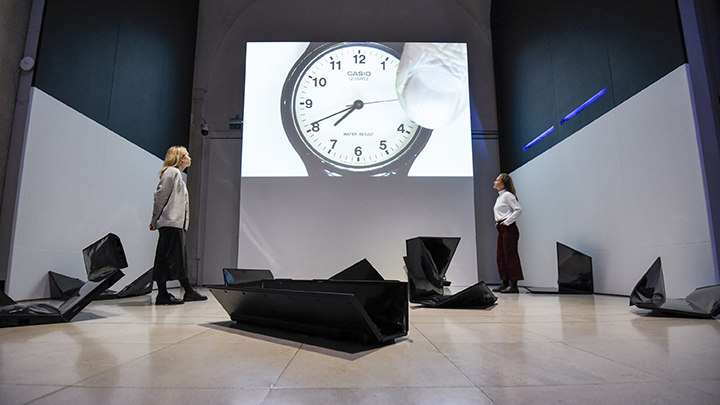
Benjamin Grosser’s Order of Magnitude (2019), a film containing excerpts of Mark Zuckerberg’s interviews, covering the earliest days of Facebook in 2004 up to Zuckerberg’s appearances before the US Congress in 2018, these recordings reveal what’s changed and what hasn’t changed about the way he speaks and what he says. The film shows him boasting the enormity of Facebook, where the edits present us with him repetitively announcing “more, more, more, growth, more than a billion, much bigger, another billion, more than a hundred billion, more efficient, growing, even more, growing by 50%, billion, more billions, many many more”.
Many have become disillusioned with Silicon Valley and its technology based corporations, and the systems and platforms, which they have co-created at the expense of our privacy. The problem is, we are the silent workforce that these companies feed on. By giving away raw data for analysis and material extraction, we fuel the machine of surveillance capitalism. Unsurprisingly, this is reflected by a significant portion of artworks in the exhibition, which are concerned with what the contemporary meaning of labour is now.
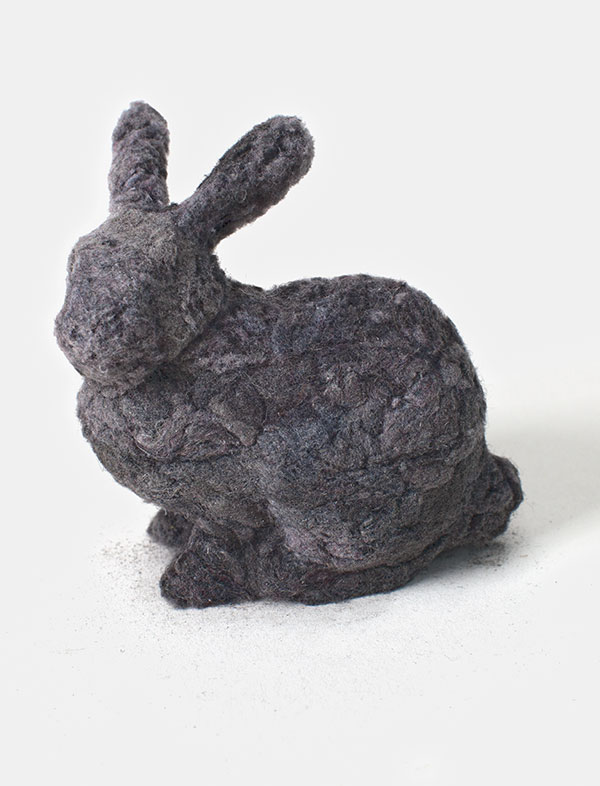
As we enter the age of acceleration and automation, much of our labour is done with the help of machines. As this happens more we will need to keep re-evaluating our position in the process. On the one hand, 24/7 seems to portray humans as slaves to the machines, while our lifestyles are twisted, over full, and packed with too much stuff. Esmeralda Kosmatopoulos presents us with her sculptures of various configurations of empty hands, the fingers arranged to show them presumably texting, holding a phone and sliding up the screen. (Fifteen Pairs of Mouths, 2016-19).
Then we have Tega Brain’s, Unfit Bits (2015), pointing to constant connectedness; relentlessly moving metronomes stimulating smartwatches for those whose insurance forces them to rely on the health and physical performance data, and then Jeremy Bentham’s famous 19th century drawings of the Panopticon.
Many of the artworks in the exhibition work to debunk the myth of immaterial labour. For instance, this is poetically illustrated by Alan Warbuton’s Dust Bunny (2015), a sculpture comprised of finely milled angora-like dust harvested from the inside of ten 3D animation workstations at visual effects studio Mainframe. The volume of dust here represents an estimated 35,000 hours, or 4 years, of constant rendering and processing.
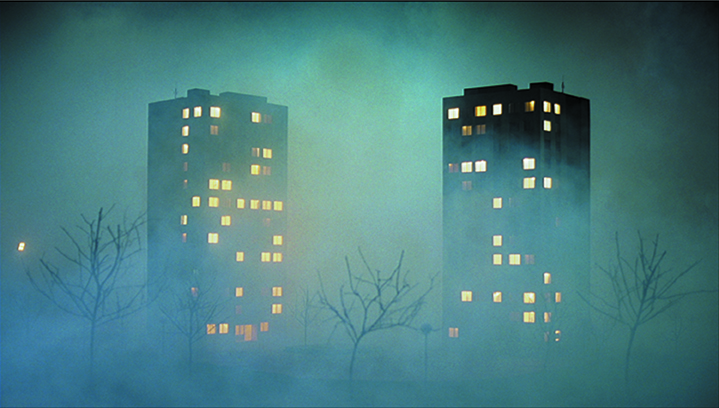
The distressing nature of social media is shown through the lens of architecture rationalising human relations in Pierre Huyghe’s The House Project (2001). The film shows computer-generated high-rise blocks with window lights blinking in the rhythm of the electronic soundtrack by Finnish techno duo Pan Sonic and French sound artist Cédric Pigot. As the track progresses, the beat becomes heavier, faster and the lights begin to run up and down the stairs, across all floors. The two apartment blocks become musical instruments with flashing diodes, generating an eerie and creepy soundtrack.
Among this horde of artworks, there are some which allow space for contemplation. Finnish artist Nastja Säde Rönkkö, one of the Somerset House Studios’ residents, spent 6 months living and working in London without using Internet. Her letters, souvenirs and received gifts are displayed in a glass cabinet, alongside the film documenting her experiences of moving around the city and reflections on the difficulties she had encountered when she refused to use and benefit from the web. In Catherine Richards’ Shroud Chrysalis I (2000), the visitors are invited to be wrapped in a copper blanket by the gallery attendants, and savor time off technology, as the blanket blocks out electromagnetic signals emitted by mobile devices.
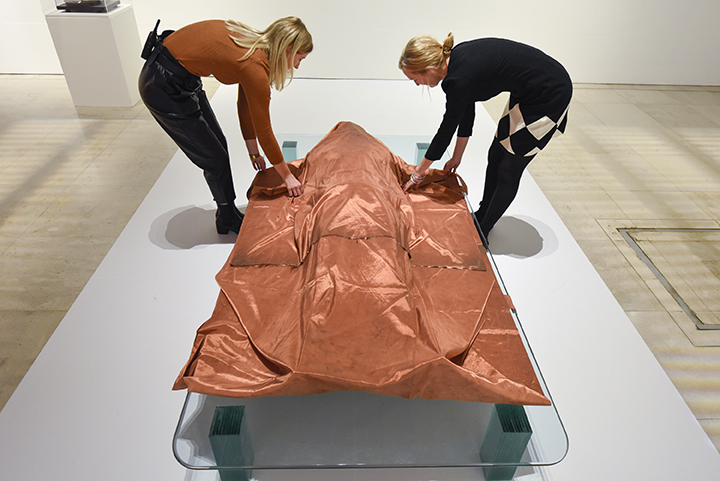
The show proposes a retreat and asks us to contemplate the world’s speed and our disconnectedness from a sense of time. At the same time, it overwhelms the space with an abundant amount of artworks, with over 50 beautiful and innovative artworks on display. And, while this diversity is one of the exhibition’s biggest strengths and should be applauded, it is also a weakness. It involved much shifting about and squeezing between displays, and tireless engagement. One’s experience of this ranged from disinterest to awe, as well as disorientation.
The exhibition’s theme is about time. It literally demands a fair chunk of time forcing the visitor to slow down and re-evaluate experiences and perceptions of what time means to us when its so deeply a part of the systems that are accelerating, alongside capitalist means. This big show offers us no way out of the contemporary trappings of capitalism and its intertwined, connections with time. But, it has opened up a space where we can consider it in a context where it involves the mediums and processes of, art, technology, and varied philosophical, political interjections, and observed outlooks. The exhibition presents us the visitor with an opportunity to reflect on the connected world through the experience of disconnectedness which has successfully been woven into the exhibition’s concept. The works shift and turn not with one message, but as oracles, or reminders that, there is a possibility of living differently, where we can create communities in alternative ways and highlight the value of questioning, while critically experimenting with our methods of communication. Time or capitalism, are not the main messages, but it’s more about what we do with them. It is an important and necessary exhibition that needs our immediate attention.
24/7:
A WAKE-UP CALL FOR OUR NON-STOP WORLD
is at Somerset House in London until 23 Feb 2020
somersethouse.org.uk/whats-on/247
Featured Image:
‘Slogans for the 21st Century’
Courtesy of Douglas Coupland
and Maria Francesca Moccia, EyeEm
via Getty Images
Featured Image: Black Shoals: Dark Matter’, Joshua Portway, Lise Autogena, Big Bang Data.
Big Bang Data is a major travelling exhibition currently set within London’s Somerset House. That a large institution is presenting a journey via data capture through ‘selfies, surveillance and infographics’ is in itself an interesting patchwork of intent and realisation. The aim of the exhibition is to ‘demystify data’. This is a grand, summative and in actuality slightly awkward claim which, in my view, encapsulates the character of an interesting, textured exhibition in an unintentionally astute way.
As Big Bang Data is dedicated to revealing data comprehensively through its various architectures and iterations, it makes sense for the underrepresented materiality of information to have prominence early on. This materiality, perhaps inevitably, was compromised in the gallery space. Entering the first room brings you face to face with Timo Arnall’s Internet Machine, which takes the form of multiscreen video documentation of not just the machines, but also the architecture, which supports mobile telephony.
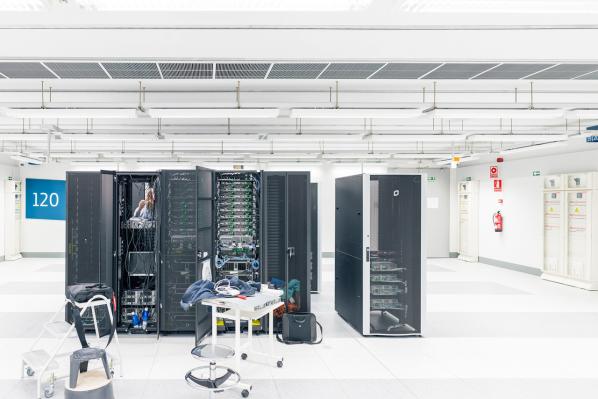
I would have loved to have experienced the spaces shown more intimately and walked around one of these structures; the installation was illuminating but I was still most certainly watching at a remove. This initial interplay of removal and involvement is central to the way we experience data. How can people begin to understand something which exists as multiple codes and flows, on a scale and at a speed which is not concerned with making itself understood by humans? What form could an understanding of data possibly take? When learning about something this far from our grasp, it seems that ‘understanding’ must be replaced by ‘awareness’. Rather than seeking one answer via one route the visitor to Big Bang Data has to build an impression, obviously subjective and subject to change.
In its quest to expose and explain data’s social and cultural uses, it presents a fairly overwhelming amount of information. It is interesting to walk through the space thinking about how this information has been channeled by each specific project. Some representations, such as Owen Mundy’s ‘I Know Where Your Cat Lives’, link distant people and spaces via connected points, while others such as Phillip Adrian’s ‘One Second’ capture in great detail one specific point in time and space.
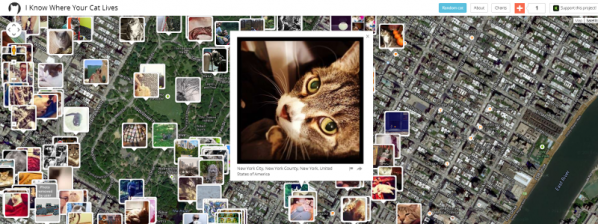
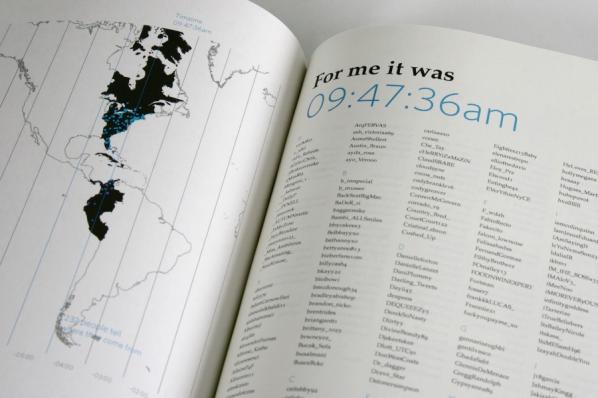
Julian Oliver’s ‘Transparency Grenade’ brings together graphical, console and physical representations of data to offer a transportable means of leaking information as a response to impenetrable governing systems. Each of the works on display demonstrates a negotiation between temporality, materiality and spatiality, and often one is sidelined in favour of the other. Again, considering the exhibition in this way is also to consider the world of data in all its contrariness.
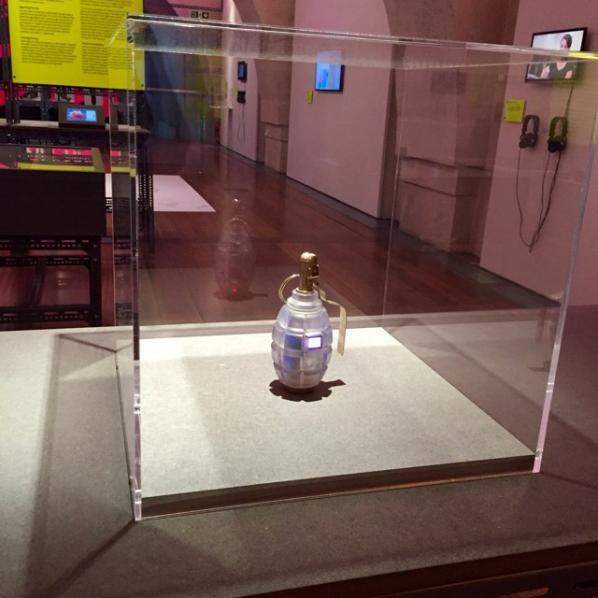
Data manifests itself at the same time locally and globally. As well as addressing specificity, the projects shown in Big Bang Data dwell repeatedly on scale. Works such as Tejka’s ‘London Data Streams’ and Nicholas Felton’s ‘Annual Reports’ pit scales against each other to cast light on the filters through which data is processed.

Ingo Günther’s ‘World Processor’ and Forensic Architecture’s ‘Liquid Traces: The Left-To-Die Boat Case’ are examples of resonant, atypical data visualisations which mutate familiar imagery and present alternative summaries of events. The section entitled ‘Data For The Common Good’ shows some of the ways data is being actively used in society to empower citizens with works such as Safecast’s ‘bGeigie Nano’ and IF’s ‘Data Licenses’, while a series of video interviews with journalists and other professionals working with data illuminate the processes through which information becomes communication.

The previously mentioned tension between object and their presentation recurs at various points throughout the exhibition, a great example being the array of undersea telephone cables, presented in cases of wood and glass which could have been magpied from a display of historical artifacts (each cable segment has a number next to it which corresponds to a factual description). It felt strange not being able to touch them. A work which I felt fully occupied, and knowingly played with, its surroundings was Ellie Harrison’s vending machine, which sits unassumingly in the gift shop; its secret is that when search terms connected to the recession make the headlines, free snacks are dispensed. Its presence in a exhibition on data in a gallery space felt appropriate.

Big Bang Data, which runs alongside a programme of events and has previously been exhibited at CCCB in Barcelona, comes at a moment where large organisations are more frequently bringing concepts such as surveillance, open source and free software into public spaces. There is a great need to bring the concepts and processes surrounding data more wholly into the public eye, and this exhibition strikes me as, overall, a big step in a good direction. It makes real and challenging efforts to bring together world-spanning processes, complex concepts and extremely diverse content into an exhibition space. The task of the exhibition’s curatorial and production teams must have been difficult.
Of course the challenges they faced have been dealt with before many times in many ways, and of course the practical decision-making involved in producing an exhibition invariably creates tension points. The reason I’ve dwelt on the problems of the organisers here is that the tensions evidenced within the space at Somerset House say much not just about the response of the publicly funded arts to data but also about the nature of data itself. The exhibition turns into at times a museum, a bedroom, a classroom, an information point, a scruffy new gallery space and a state of the art new media space. In bringing together the story of data the exhibition also brings together the story of representation in space more generally.
In writing about Big Bang Data I have had to choose to highlight certain works and not others. Your interpretation will be entirely different from mine, which is as it should be where data and cultural inclusion is concerned. What’s important is that the exhibition’s prominence and texture opens up conversation and critique. The exhibition is detailed, procedural and expansive. It is also alive with contrariness, generality and awkwardness. Perhaps one of the great things about the show is that these qualities are left to jostle for space. For me, reading this exhibition as a performative event was useful; others may leave Somerset House with an entirely different view having taken an entirely different route. This is inevitable where data is concerned – learning is incremental and procedural, but not traditionally linear.